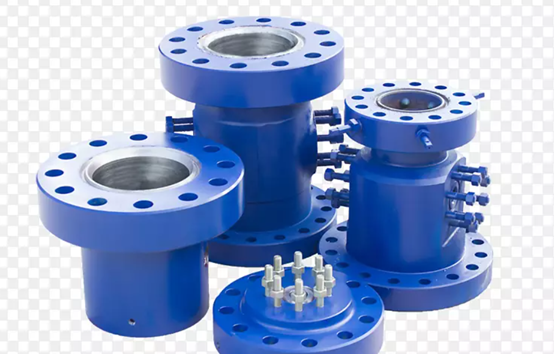Overview
A casing head is a crucial component in oil and gas wells, situated between the casing and the wellhead equipment. It serves several key functions, including connecting different layers of casing, linking the casing to the blowout preventer, and providing support and connection for the wellhead after well completion. Its design is essential for maintaining wellhead stability, ensuring effective sealing, and supporting a range of drilling and production activities.
Structure and Connections
- Lower Connection: The lower end of the casing head is threaded to connect securely to the surface casing, providing a stable foundation.
- Upper Connection: The upper end connects to the wellhead equipment or blowout preventer via flanges or clamps, facilitating efficient installation and integration with these components.
- Hanger: The hanger supports the weight of the subsequent casing layers and bears the load of the blowout preventer, ensuring the wellhead system remains stable.
Main Functions
- Support and Load Bearing:
- Support: The casing head’s hanging device supports the weight of all casing layers beyond the surface casing, ensuring the structural integrity of the wellhead.
- Load Bearing: It accommodates the weight of the blowout preventer assembly, maintaining the overall stability of the wellhead system.
- Sealing:
- It provides effective pressure sealing between the inner and outer casings to prevent fluid leaks from the wellhead.
- Pressure Relief:
- It offers an outlet for releasing any pressure that may build up between casing columns. In emergencies, fluids such as kill drilling fluids, water, or high-efficiency fire-fighting agents can be pumped into the well to stabilize pressure.
- Support for Special Operations:
- It enables specialized drilling and production operations, such as injecting cement through side holes to enhance casing integrity, or applying pressure through side holes during acidizing or fracturing to manage pressure within the tubing.
Features
- Connection Methods: The casing head accommodates both threaded and clamp connections, offering flexible and efficient installation options for quick casing suspension.
- Sealing Structure: It utilizes a composite sealing structure combining rigid and rubber materials, with optional metal seals available to enhance leak prevention and sealing performance.
- Wear Sleeves and Pressure Testing Tools: It includes wear sleeves and pressure testing tools designed for easy removal of wear sleeves and for conducting pressure tests on the casing head.
- Upper Flange Design: The upper flange is equipped with pressure testing and secondary grease injection devices, improving operational convenience and safety.
- Side Wing Valve Configuration: The casing head can be fitted with side wing valves based on user specifications to address various operational requirements.
Summary
The casing head is a vital element in oil and gas wells, with its design and functionality significantly affecting the stability, sealing, and efficiency of drilling and production operations. By providing essential support, effective sealing, pressure relief, and support for specialized tasks, the casing head plays an indispensable role in the oil and gas extraction process.
Post time: Sep-20-2024





